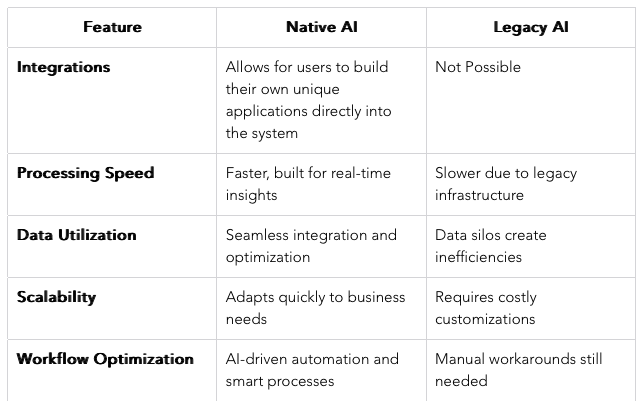Many CEOs and CFOs we work with are actively exploring native artificial intelligence (AI) and its potential impact on revenue growth, innovation, and operational efficiency. AI is no longer just a buzzword—it’s a powerful tool reshaping business strategy. In fact, 91% of executives expect AI to drive revenue growth within the next five years (Source: Forbes, 2024). But not all AI solutions are created equal. Native AI, built from the ground up, is proving to be far superior to legacy AI solutions that merely add AI as an afterthought.
How AI is Driving Business Growth
Revenue Expansion
AI is helping businesses uncover new markets and revenue streams. 68% of CFOs report increased accuracy and error reduction, leading directly to revenue growth (Source: Gartner, 2024). AI-driven insights also enhance pricing strategies, customer segmentation, and demand forecasting, allowing businesses to optimize their revenue potential.
Innovation Acceleration
AI enables real-time “what-if” analysis and unlocks deeper customer insights. Businesses can quickly prototype new products, personalize user experiences, and forecast trends with high precision, staying ahead of competitors.
Operational Efficiency
AI automates tasks traditionally handled by junior accountants, streamlining workflows and reducing costs. From finance and HR to supply chain management, AI-driven automation increases productivity and allows teams to focus on strategic initiatives rather than mundane tasks.
Native AI vs. Legacy AI: A Game Changer
Many organizations find themselves stuck with "Frankenstein" tech stacks—a patchwork of on-premise solutions, SaaS applications, and third-party integrations. At Everest Systems, we eliminate the need for costly developers or third-party software apps bolted onto legacy applications. Imagine a world where, in just months, your team can ask Native AI to build custom workflows and processes directly within the system—without external dependencies.
Native AI eliminates these inefficiencies by offering:

At Everest Systems, we eliminate the need for costly developers or third-party software add-ons. Imagine a world where, in just months, your team can ask Native AI to build custom workflows and processes directly within the system—without external dependencies.
How to Transition to Native AI
91% of executives expect AI to drive revenue growth within the next five years
If your organization is still relying on legacy AI solutions, now is the time to make the switch. Here’s a simple roadmap to get started:
Obtain CFO Sponsorship - Your CFO is probably thinking about Native AI
Identify Inefficiencies – Assess your current AI and tech stack to pinpoint bottlenecks.
Evaluate AI Readiness – Determine what data and processes can be optimized with AI.
Implement in Phases – Start with high-impact areas such as finance, operations, and customer service.
Leverage AI Expertise – Partner with a Native AI provider like Everest Systems to ensure a smooth transition.
The Future of AI is Native
The future of ERP is here, and it’s Native AI. Let’s build it together.
Cameron Ackbury, CPA
Advisor to the Office of the CFO
cameron@everest-erp.com
+1 650-223-4557




